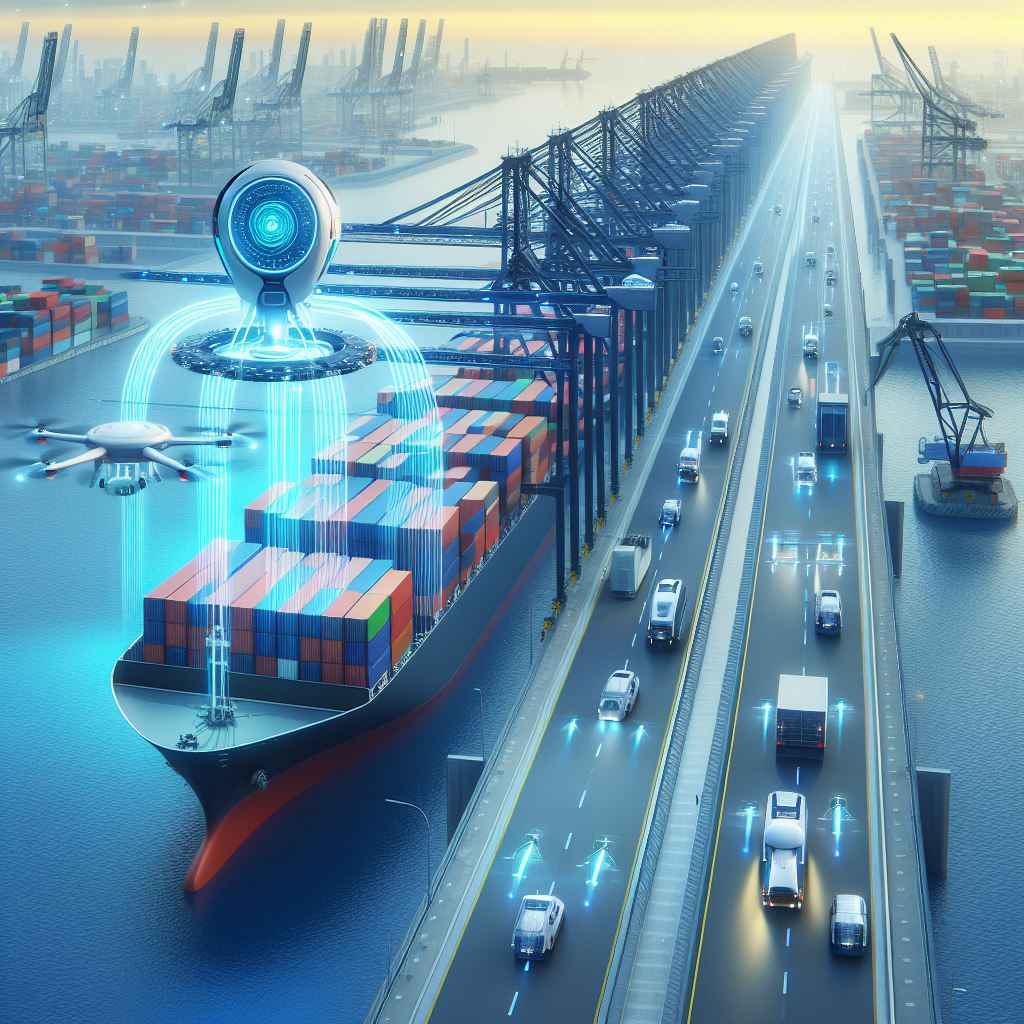Smoothing Cross-Border Shipping: The Power of AI in Logistics
We’ve all been there. You find the perfect outfit online, hit purchase with glee, then… crickets! The tracking info is a mystery, and your package seems to be on a global odyssey.
For international businesses, these cross-border shipping struggles can be a major headache. Lost packages, frustrated customers, and mountains of paperwork can slow down even the most ambitious entrepreneur. But what if there was a solution? What if technology could transform this labyrinthine process into a seamless journey?
AI, with its ability to process vast amounts of data and make intelligent decisions, is transforming the landscape of logistics. By harnessing AI-driven solutions, businesses can optimize routes, predict demand fluctuations, and mitigate risks, leading to greater efficiency and cost savings. Let’s find out more!
The Cross-Border Shipping Nightmare: A Breakdown of Common Pain Points
Cross-border shipping can often feel like navigating through a labyrinth of challenges, with each twist and turn presenting a new obstacle to overcome. Let’s break down some of the most common pain points that businesses encounter in this shipping nightmare:
-
Complex Documentation and Customs Clearance Procedures
When shipping goods across borders, businesses are faced with a barrage of paperwork and customs requirements. From import/export declarations to duty calculations, the documentation process can be overwhelming and time-consuming.
-
Difficulty Navigating Different Regulations and Taxes Across Borders
Every country has its own set of regulations, tariffs, and taxes governing imports and exports. Navigating this maze of regulations can be a daunting task for businesses, leading to potential compliance errors and unexpected costs.
-
Unpredictable Shipping Times and Potential Delays
International shipping comes with inherent uncertainties, including variable transit times and the possibility of delays due to factors like weather, customs inspections, or transportation disruptions. These uncertainties can make it difficult for businesses to meet customer expectations for delivery times.
-
Increased Risk of Lost or Damaged Packages During International Travel
The longer the journey, the greater the risk of packages getting lost, damaged, or misplaced along the way. International shipments are particularly susceptible to these risks, posing potential financial losses and customer dissatisfaction for businesses.
-
Lack of Real-Time Tracking Visibility for Businesses and Customers
Without real-time tracking capabilities, businesses and customers are left in the dark about the status and location of their shipments. This lack of visibility can lead to frustration and uncertainty, making it difficult to effectively manage logistics and customer service.
AI to the Rescue: How Artificial Intelligence is Transforming Logistics
-
Automating Customs Clearance Processes with AI-Powered Tools
Think about this: a shipment full of your amazing handcrafted jewelry is ready to head overseas, but the thought of customs clearance fills you with dread. Mountains of paperwork, complex regulations, and the potential for delays can make international shipping a logistical nightmare.
But fear not, entrepreneur! Artificial Intelligence (AI) is emerging as a powerful tool to automate and streamline customs clearance processes.
Traditionally, customs clearance involves a mountain of documentation. Each shipment requires detailed declarations specifying the goods, their value, origin, and destination. This information is crucial for customs authorities to assess duties, taxes, and potential security risks. However, manually filling out these forms can be incredibly time-consuming and prone to errors. A single mistake can lead to delays, additional costs, and even shipment seizures.
This is where AI-powered tools come to the rescue. These intelligent systems use machine learning algorithms to analyze and interpret customs documents with remarkable accuracy. Here’s how it works:
- Data Powerhouse: AI tools are trained on vast amounts of customs data, including regulations, product classifications, and historical shipment information.
- Document Analysis: When presented with your shipment details, the AI can automatically extract relevant information from invoices, packing lists, and product specifications.
- Classification Expertise: AI algorithms can then classify your goods based on Harmonized System (HS) codes, which are international standards used to identify and categorize traded products. This ensures your products are declared accurately and avoids confusion with customs authorities.
- Smart Declaration Generation: Based on the extracted data and product classification, the AI can generate a complete and accurate customs declaration form, saving you countless hours of manual work
-
Utilizing AI for Real-Time Risk Assessment and Route Optimization
The world of logistics can be a complex interplay between speed, efficiency, and cost. Delays due to unforeseen circumstances can disrupt schedules, frustrate customers, and eat into profits. But what if there was a way to anticipate these disruptions and proactively adjust your shipping strategy? Enter AI, a game-changer in the realm of logistics.
AI is being increasingly utilized for real-time risk assessment and route optimization. These intelligent algorithms act as your virtual logistics navigator, constantly analyzing data to ensure your shipments reach their destinations smoothly and efficiently. Here’s a deeper dive into this powerful technology:
-
Data Gathering: The Fuel for AI
Imagine a massive information pool constantly feeding AI algorithms. This pool comprises various data sources, including:
- Weather Forecasts: Real-time and historical weather data helps predict potential delays caused by storms, snow, or extreme heat.
- Traffic Patterns: Live traffic data helps identify congested areas and allows for route adjustments to avoid gridlock.
- Historical Shipping Data: Past experiences with specific routes, carriers, and customs procedures provide valuable insights for future planning.
- Road Closures and Restrictions: Information about road closures, accidents, or construction zones helps AI suggest alternative routes.
-
Predictive Power: Anticipating Challenges
By analyzing this vast amount of data, AI can identify potential risks that could disrupt your shipment. Imagine a blizzard brewing on your usual route – the AI can predict this based on weather forecasts and historical data.
-
Dynamic Route Optimization: Reacting in Real-Time
Here’s where the magic happens. AI doesn’t just identify risks; it helps you avoid them! Based on real-time data and predicted outages, AI can dynamically suggest alternative routes. These alternative routes consider factors like:
- Estimated Travel Time: AI calculates the estimated travel time for each potential route, ensuring your shipment arrives on schedule.
- Traffic Conditions: Real-time traffic data is factored in to avoid congested areas and ensure smooth sailing (or driving!).
- Cost-Effectiveness: AI can even consider fuel costs and tolls when suggesting routes, helping you optimize your logistics budget.
-
Predictive Analytics for Accurate Delivery Time Estimations
In the age of e-commerce, “When will it get here?” is a question that haunts every online shopper. For businesses, providing accurate delivery time estimates is crucial for managing customer expectations and building trust. However, traditional methods of estimating delivery times can be unreliable, often leaving both businesses and customers frustrated.
This is where predictive analytics, powered by AI, steps in as a game-changer. These intelligent systems leverage historical data and real-time insights to forecast delivery times with unprecedented accuracy. Here’s how it works:
- Learning from the Past: AI algorithms are trained on massive amounts of historical shipping data. This data includes information like past delivery times, routes taken, carrier performance, and even weather patterns.
- A Factor for Everything: Predictive analytics considers more than just distance when estimating delivery times. Factors like traffic congestion in specific regions, seasonal variations in shipping volume, and even potential customs delays are all factored into the equation.
- The Power of Real-Time Data: AI doesn’t just rely on historical information. It also incorporates real-time data feeds, such as weather forecasts and current traffic conditions, to provide the most up-to-date estimates.
By analyzing this vast amount of data, AI can predict potential delays and provide several key benefits:
- Accurate Delivery Time Estimates: Gone are the days of vague delivery windows. Predictive analytics allows businesses to provide customers with more specific and accurate delivery timeframes, reducing frustration and setting realistic expectations.
- Improved Customer Experience: Transparency is key! With real-time updates on shipment progress, customers can track their orders and feel confident about when to expect their purchases. This leads to a more positive and trusting customer experience.
- Reduced Missed Deadlines: By identifying potential delays early on, businesses can take proactive measures, such as choosing alternative routes or contacting customers to manage expectations. This helps businesses avoid missed deadlines and maintain a positive reputation.
- Enhanced Planning and Operations: Accurate delivery time predictions enable businesses to improve their internal logistics planning. They can optimize staffing schedules, warehouse operations, and communication with customers based on predicted arrival times.
-
AI-Powered Chatbots for Improved Customer Service and Support
AI-powered chatbots are transforming customer service and support in the logistics industry.
At the core of a chatbot’s functionality lies Natural Language Processing (NLP). This branch of AI allows the chatbot to understand and respond to human language. Here’s how it works:
- Understanding Your Questions: When you interact with a chatbot, whether through text messages or voice commands, NLP allows it to analyze your query and identify the keywords and intent behind your message.
- Formulating a Response: Based on its understanding of your question, the chatbot retrieves relevant information from a vast knowledge base or database. It then uses this information to formulate a clear, concise, and informative response tailored to your specific inquiry.
But chatbots aren’t static – they continuously learn and improve! This is thanks to machine learning algorithms. Here’s how machine learning empowers chatbots:
- Learning from Every Interaction: With each customer interaction, the chatbot analyzes the conversation and the outcome. This allows it to refine its responses over time, becoming more adept at handling similar queries in the future.
- Evolving Expertise: Machine learning algorithms enable chatbots to expand their knowledge base and handle a wider range of customer inquiries. This ensures they can provide accurate and relevant information on various logistics topics.
Benefits of Using AI in Cross-Border Shipping
- Streamlined Customs Clearance: AI automates document analysis, classification, and declaration generation, reducing errors, expediting processing, and minimizing delays at customs.
- Real-Time Risk Assessment and Route Optimization: By analyzing vast amounts of data, AI predicts potential disruptions (weather, traffic) and dynamically adjusts shipping routes, leading to faster deliveries and reduced costs.
- Accurate Delivery Time Estimations: Predictive analytics powered by AI consider various factors to provide customers with realistic and up-to-date delivery timeframes, improving transparency and managing expectations.
- Enhanced Customer Service: AI-powered chatbots handle routine inquiries 24/7, answer questions about tracking and deliveries, and even offer personalized support based on past interactions, leading to higher customer satisfaction.
- Improved Efficiency and Cost Savings: AI automates tasks, optimizes routes, and reduces errors, leading to faster processing times, lower operational costs, and ultimately, improved profit margins for businesses involved in cross-border shipping.
Conclusion
Businesses can leverage AI to automate customs clearance, optimize routes, and gain valuable data insights for better decision-making. This translates to faster deliveries, reduced costs, and a happier customer base. Customers, on the other hand, benefit from real-time tracking, accurate delivery estimates, and convenient AI-powered chatbots that answer their questions 24/7. As AI technology continues to develop, the future of cross-border shipping promises even greater efficiency, transparency, and a seamless experience for everyone involved.
Ready to streamline your cross-border shipping with AI-powered solutions? Contact RTS Labs now to unlock greater efficiency, minimize delays, and improve customer satisfaction in your logistics operations!






